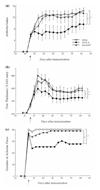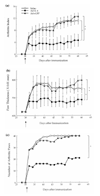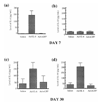Gene therapy for established murine collagen-induced arthritis by local and systemic adenovirus-mediated delivery of interleukin-4
- PMID: 11056670
- PMCID: PMC17812
- DOI: 10.1186/ar104
Gene therapy for established murine collagen-induced arthritis by local and systemic adenovirus-mediated delivery of interleukin-4
Abstract
To determine whether IL-4 is therapeutic in treating established experimental arthritis, a recombinant adenovirus carrying the gene that encodes murine IL-4 (Ad-mIL-4) was used for periarticular injection into the ankle joints into mice with established collagen-induced arthritis (CIA). Periarticular injection of Ad-mIL-4 resulted in a reduction in the severity of arthritis and joint swelling compared with saline- and adenoviral control groups. Local expression of IL-4 also reduced macroscopic signs of joint inflammation and bone erosion. Moreover, injection of Ad-mIL-4 into the hind ankle joints resulted in a decrease in disease severity in the untreated front paws. Systemic delivery of murine IL-4 by intravenous injection of Ad-mIL-4 resulted in a significant reduction in the severity of early-stage arthritis.
Figures







Similar articles
-
Effective treatment of established murine collagen-induced arthritis by systemic administration of dendritic cells genetically modified to express IL-4.J Immunol. 2001 Mar 1;166(5):3499-505. doi: 10.4049/jimmunol.166.5.3499. J Immunol. 2001. PMID: 11207309
-
Co-expression of IL-18 binding protein and IL-4 regulates Th1/Th2 cytokine response in murine collagen-induced arthritis.Acta Biochim Biophys Sin (Shanghai). 2008 Feb;40(2):116-24. doi: 10.1111/j.1745-7270.2008.00384.x. Acta Biochim Biophys Sin (Shanghai). 2008. PMID: 18235973
-
Adenoviral transfer of the viral IL-10 gene periarticularly to mouse paws suppresses development of collagen-induced arthritis in both injected and uninjected paws.J Immunol. 1999 Mar 15;162(6):3625-32. J Immunol. 1999. PMID: 10092823
-
[Serum IL-18 levels in mice with collagen-induced arthritis treated by recombinant adenovirus containing mIL-18BP and mIL-4 fusion gene].Zhejiang Da Xue Xue Bao Yi Xue Ban. 2011 Mar;40(2):195-9. doi: 10.3785/j.issn.1008-9292.2011.02.013. Zhejiang Da Xue Xue Bao Yi Xue Ban. 2011. PMID: 21488217 Chinese.
-
Gene therapy for rheumatoid arthritis. Lessons from animal models, including studies on interleukin-4, interleukin-10, and interleukin-1 receptor antagonist as potential disease modulators.Rheum Dis Clin North Am. 2002 Feb;28(1):127-49. doi: 10.1016/s0889-857x(03)00073-5. Rheum Dis Clin North Am. 2002. PMID: 11840694 Review.
Cited by
-
Molecular targeting of hepatocyte growth factor by an antagonist, NK4, in the treatment of rheumatoid arthritis.Arthritis Res Ther. 2013 Jul 22;15(4):R75. doi: 10.1186/ar4252. Arthritis Res Ther. 2013. PMID: 23876175 Free PMC article.
-
Perspectives on the use of gene therapy for chronic joint diseases.Curr Gene Ther. 2008 Aug;8(4):273-86. doi: 10.2174/156652308785160638. Curr Gene Ther. 2008. PMID: 18691023 Free PMC article. Review.
-
Poxvirus interleukin-4 expression overcomes inherent resistance and vaccine-induced immunity: pathogenesis, prophylaxis, and antiviral therapy.Virology. 2011 Jan 20;409(2):328-37. doi: 10.1016/j.virol.2010.10.021. Epub 2010 Nov 10. Virology. 2011. PMID: 21071055 Free PMC article.
-
High-efficiency gene transfer into nontransformed cells: utility for studying gene regulation and analysis of potential therapeutic targets.Arthritis Res. 2002;4 Suppl 3(Suppl 3):S215-25. doi: 10.1186/ar560. Epub 2002 May 9. Arthritis Res. 2002. PMID: 12110141 Free PMC article. Review.
-
Identification of novel rheumatoid arthritis-associated MiRNA-204-5p from plasma exosomes.Exp Mol Med. 2022 Mar;54(3):334-345. doi: 10.1038/s12276-022-00751-x. Epub 2022 Mar 30. Exp Mol Med. 2022. PMID: 35354913 Free PMC article.
References
-
- Evans CH, Robbins PD. Gene therapy for arthritis. J Rheum. 1994;21:779–782. - PubMed
-
- Robbins PD, Evans CH. Prospects for treating autoimmune and inflammatory disease by gene therapy. Gene Ther. 1996;3:187–189. - PubMed
-
- Suzuki H, Sugiyama E, Tunru IS, et al. Suppressive effect of interleukin-4 (IL-4) on IL-6 production by adherent rheumatoid synovial cells. Clin Immunol Immunopathol. 1993;66:67–72. - PubMed
-
- van Roon JA, van Roy JL, Gmelig-Meyling FH, Lafeber FP, Bijlsma JW. Prevention and reversal of cartilage degradation in rheumatoid arthritis by interleukin-10 and interleukin-4. Arthritis Rheum . 1996;39:829–835. - PubMed
Publication types
MeSH terms
Substances
Grants and funding
LinkOut - more resources
Full Text Sources
Other Literature Sources
Medical

